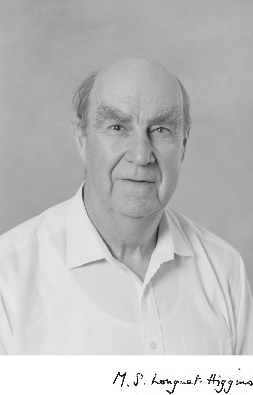Michael S. Longuet-Higgins facts for kids
Quick facts for kids
Michael S. Longuet-Higgins
|
|
|---|---|
 |
|
| Born | 8 December 1925 Lenham, England
|
| Died | 26 February 2016 (aged 90) Cambridge, England
|
| Nationality | British |
| Citizenship | United Kingdom |
| Alma mater | |
| Known for |
|
| Awards |
|
| Scientific career | |
| Fields |
|
| Institutions | |
| Doctoral advisors |
|
Michael Selwyn Longuet-Higgins (born December 8, 1925 – died February 26, 2016) was a brilliant British mathematician and oceanographer. He worked at Cambridge University in England and the University of California, San Diego in the USA. He was known for his important work on how fluids move, especially ocean waves. He also invented "rhombo blocks," which are a fun mathematical toy.
Contents
Michael's Early Life and Learning
Michael was born in Lenham, Kent, England. He had an older sister, Patricia, and an older brother, Christopher. He went to The Pilgrims' School and Winchester College. He studied there with famous people like Freeman Dyson and James Lighthill.
In 1943, when he was just 17, Michael won a special scholarship. This allowed him to study mathematics at Trinity College, Cambridge. He finished his first degree in mathematics in only two years, by 1945. Later, in 1951, he earned his PhD in geophysics, which is the study of Earth's physical processes.
His Work and Discoveries
Michael Longuet-Higgins studied many interesting things. He looked at pure mathematics, like shapes and patterns. He also studied applied mathematics, which uses math to solve real-world problems.
His main focus was fluid dynamics, which is about how liquids and gases move. He researched how wind creates ocean waves and how bubbles behave in water. He also studied microseisms, which are small tremors in the Earth caused by ocean waves.
Towards the end of World War II, Michael started working for the Admiralty Research Laboratory. He helped predict ocean waves and currents. This was important for planning landings during the war.
In 1948, he went back to Cambridge for his PhD. After getting his PhD, he spent a year in the USA. He worked at the Woods Hole Oceanographic Institute and the Scripps Institution of Oceanography.
In 1954, he joined the National Institute of Oceanography. There, he continued to study ocean waves and storm surges. He became a Fellow of the Royal Society in 1963, which is a big honor for scientists.
Michael also taught and researched at other universities. He worked at MIT, the University of Adelaide in Australia, and the University of California, San Diego. From 1967 to 1969, he was a professor at Oregon State University.
From 1969 to 1989, he was a special research professor at University of Cambridge. Even after "retiring" in 1989, he moved to California and kept working. He joined the Institute for Nonlinear Science at University of California, San Diego (UCSD). He continued his research at Scripps Institution of Oceanography until 2001. Even after that, he remained active in science.
Awards and Honors
Michael Longuet-Higgins received many important awards for his scientific work. These include:
- The Rayleigh Prize for Mathematics from Cambridge University (1950)
- Being made a Fellow of the Royal Society (1963)
- Honorary doctorates from universities in Copenhagen and Glasgow (1979)
- Becoming a member of the US National Academy of Science (1979)
- The Sverdrup Gold Medal for his work in meteorology (1983)
- The International Coastal Engineering Award (1984)
- The Oceanography Award (1990)
- Becoming an Honorary Fellow of the Acoustical Society of America (2002)
His Family Life
Michael Longuet-Higgins married Joan Redmayne Tattersall in December 1958. They had four children: Ruth, Mark, John, and Anne. Their children grew up in different places, including England and various cities in California and Oregon, as Michael moved for his research.
Selected Publications
Michael Longuet-Higgins published many scientific papers. One important work was about "Uniform Polyhedra" in 1954. You can find a full list of his publications online.
- Full List of Publications

